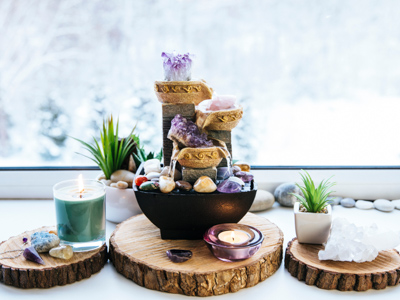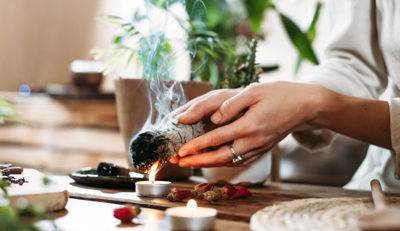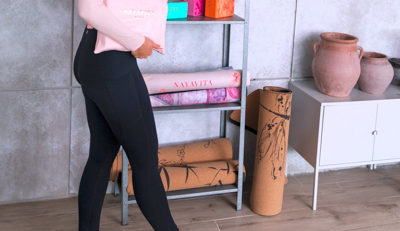Home altar definition and set-up
An altar is not something only to be found in churches, temples, and Eastern cultures. Altars are indoor and outdoor, personal, family, and public, ritual and permanent, dedicated or general. There are many types of altars, and they can play an important role even in our modern world. An altar is a personal sacred place filled with an intent, and our energy, thoughts, and views. Let’s talk about why having a home altar is a good idea and how to set one up.
What is a home altar?
Home altar is our personal sacred place that reminds us of our spirituality and what is important to us. It is a peaceful place where we project our intent and concentrate the energy required to achieve it. “The altar is a place that helps us enter our Heart. A place where we can experience God’s presence. It helps us to enter one’s own power and to become aware of oneself,” says Karolina Acherati.
While a home altar can be both a designer statement and a beautiful home decoration, the most important aspect of an altar is the energy that is gathered there through our intent, and the meaning that each altar object carries for us.

Why is home altar a good idea?
Do you also sometimes have difficulty concentrating with your attention pulled in all directions? A home altar helps to concentrate energy and focus attention, thus facilitating a deeper connection with the spiritual world.
Thanks to the altar and the objects we place on it, our intentions, wishes and resolutions are always in plain sight and therefore on our mind. In this way, we keep them consciously alive, which is the basis of manifestation. It is our place where we can pray, perform rituals, meditate, ask for help, or just think and seek answers to questions.
What to put on an altar?
Antonio Koláček nicely summarized that “A personal altar is a place where a person can put what they love the most, what is important to them, what they want to support, nurture and develop.” Setting up an altar is a creative matter and one of the most intimate ways of self-expression. The typical objects on an altar are altar candles and crystals, but you can also have statues, decorative ceramic vessels, flowers, feathers, incense burners, or even a favourite accessory or paper scroll with an intent.
Home altar symbolizes the life we want. It includes things we are grateful for and those we want to grow and achieve. The main thing is the intent that we put into the altar and the meaning that individual objects and elements have for us. As such, there is no single right altar. Even if two people build an altar with the same intent, each will look different.
When choosing altar objects, it is important to represent all four elements, and in the case of seasonal altars, match the elements to the season. Flowers and symbols of rebirth are suitable for a spring altar, while for an autumn altar choose seasonal fruits, decorative gourds and perhaps chestnuts.
What does not belong on an altar?
There are only a few things that do not belong on the altar. An altar is a personal matter. So even things that may seem strange at first glance but have a deeper meaning in line with our intent and thus form a harmonious whole are fine. Pay attention to objects that look beautiful but carry unwanted energy.
These can be objects associated with negative experiences or people towards whom we harbour feelings of anger, guilt, jealousy or disappointment. For instance, a favourite piece of jewellery that was a gift from an ex-partner who hurt you and you haven’t forgiven yet does not belong on the altar.

Where to build an altar?
When choosing a place, like with the rest of set-up, it is key to follow your intuition. The altar should be in a clean, quiet place, and it is up to each of us whether that is in a private place, such as the bedroom, or, in the heart of the home, i.e. in the living room, where we share it with others including visitors.
Ask yourself how you want to use your altar. Prayer and meditation might suit a private quiet place better, whilst an altar of abundance could be better placed in a living room. And if you cannot decide, no problem. You can have multiple altars or change your altar regularly.
How to set-up a home altar?
A home altar can be on a bedside table, coffee table, shelf, cabinet, or even on the ground. Although some traditions such as Buddhism advise that it should be higher than the head when facing it seated. It is good practice to mark the altar space with natural material, such as cotton or linen cloth, or even a metal or wooden tray.
The altar set-up itself is a spiritual, rather than a transactional matter. We fill the altar with our own energy and views. It should be built with a clear and calm mind and filled with a pure intent. Before setting the altar up, go for a walk, meditate, dance, sing, draw, do yoga or take a bath. Anything that helps you calm down and feel in harmony.
How to fill your home altar with an intent?
Intent is the formulation of why you are building the altar and what you want to achieve. Don’t try to use big words or unnecessarily complicate things. Simply say in your own words what you want from the altar set-up. For example, an abundance altar can be filled with an intent like ‘I live in abundance, I am surrounded by an abundance of love, good relationships, money and opportunities in my private and professional life.’
Intent can be projected into a home altar with the placement of each altar object. Or you can even perform a small ritual. If you want to use an altar candle, light it, express gratitude for the abundance that surrounds you, and ask for support and blessings to achieve your intent. You can also call upon your ancestors, Gods, angels, or other entities for help. The same function can also be performed by an incense or a smudge stick. Light it up with an intent and use the sacred smoke to purify the altar, yourself, and all altar objects, creating a clean space for your intent to take root.

Building a home altar is a ritual, and as with any ritual, visualizing the achievement of your intent is the first step to successful manifestation. Imagine that you have already achieved your goal and what it looks like, how does it feel, maybe you can even taste it or smell it. The more senses you engage and the clearer the visualisation, the stronger the magnetism you are creating.
How to represent all 4 elements?
Representing all 4 elements is good for achieving harmonious energy around your altar. Having said it, rather than including objects without any meaning to you, it is important to be led by your intuition. All objects placed on your home altar must have a deeper meaning to you and be aligned to your intent. It often happens, that we include all elements intuitively, without trying to.
- Earth (north) – crystals, stones, flowers, fruits, plant parts
- Air (east) – smudge dish, feather, incense smoke
- Fire (south) – candle, incense, red colour
- Water (west) – bowl of water, seashell, cup, chalice
When setting up an altar, it is important to go within yourself and live and feel the intent placed into the altar. Home altar is a life entity and not a transactional home decoration built to collect dust. Discover the power of the home altar and get closer to your dreams and intentions.







Leave a Reply